Simulations & Modeling: Closed-Form to Discrete
Simulations & Modeling: Closed-Form to Discrete
Combined Educational & Scientific Session
Combined Educational & Scientific Session
ORGANIZERS: Mary McDougall, Gregor Adriany, Ergin Atalar
Thursday, 16 May 2019
| Room 710A | 08:15 - 10:15 | Moderators: Laleh Golestani Rad, Yigitcan Eryaman |
Skill Level: Intermediate
Session Number: TH-03
Overview
This course will provide the audience with an overview of fast analytical/electrodynamic and numerical simulation techniques and practices and will highlight five abstract submissions that illustrate the effective use of these tools.
Target Audience
Educational Objectives
As a result of attending this course, participants should be able to:
- Identify the differences between current analytical and numerical simulation techniques;
- Describe effective and proper use of fast analytical/electrodynamic simulation techniques; and
- Describe effective and proper use of numerical simulation techniques.
Overview
This course will provide the audience with an overview of fast analytical/electrodynamic and numerical simulation techniques and practices and will highlight five abstract submissions that illustrate the effective use of these tools.
Target Audience
Educational Objectives
As a result of attending this course, participants should be able to:
- Identify the differences between current analytical and numerical simulation techniques;
- Describe effective and proper use of fast analytical/electrodynamic simulation techniques; and
- Describe effective and proper use of numerical simulation techniques.
| 08:15 |
|
Rapid Electrodynamic/Analytic Simulations for Coil Design Optimization
Riccardo Lattanzi
Ultimate intrinsic SNR, SAR and TXE can be computed analytically in simple anatomy-mimicking geometries by using a complete set of surface current modes. The performance of RF coil designs with respect to the corresponding ultimate limits can be rapidly calculated within the same analytical simulation framework. Ideal current patterns associated with optimal performance can be also derived and can provide fundamental physical insight into what features are most important in constructing the best possible coil for magnetic resonance.
|
| 08:45 |
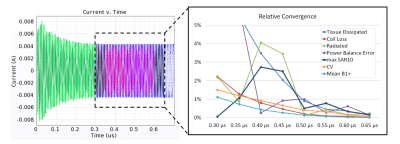 |
Efficient & Effective Numerical Simulations for RF Coil Modeling & Safety Prediction
Wyger Brink
This educational talk is tailored to the efficient and effective use of numerical simulation techniques for the assessment of safety and effectiveness of RF coil designs. Proper modeling practices will be identified, and recently developed methodologies will be discussed.
|
09:15 |
1035. 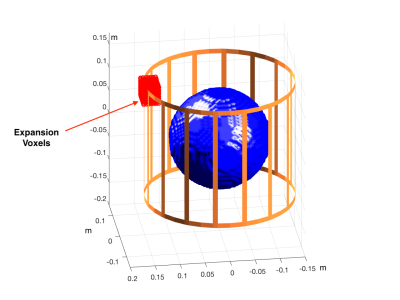 |
Fast field analysis for complex coils and metal implants in MARIE 2.0
Georgy Guryev, Athanasios Polimeridis, Elfar Adalsteinsson, Lawrence Wald, Jacob White
When multicoil transmit arrays are used in high field scanners, patient-specific optimization can improve image quality and increase safety margins, particularly for patients with implants. The feasibility of performing such optimizations in real-time was demonstrated recently[5], using a combination of fast tissue mapping and voxel-based field simulation[4], but only for a single-port coil and an implant-free patient. In this abstract we describe new techniques for simulating complex coils that accelerates MARIE simulation as much as an order of magnitude, and an efficient approach to including metal implants. We demonstrate field analysis in minutes using the open-source simulator MARIE2.0.
|
| 09:27 |
1036. 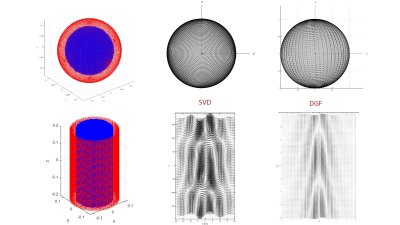 |
Ideal current patterns for optimal SNR in realistic heterogeneous head models
Ioannis Georgakis, Athanasios G. Polimeridis, Riccardo Lattanzi
We describe a method to calculate, for the first time, ideal current patterns (ICP) associated with optimal signal-to-noise ratio (SNR) in heterogeneous head models for arbitrary current-bearing substrates. We show ICP for different voxel positions in the brain and neck, magnetic field strengths, and realistic head coil substrates. Even though the optimal SNR distribution is similar for different substrates, we show that the ICP depend instead on the topology of the substrate on which they are restricted. ICP can inform non-convex radiofrequency (RF) coil optimization problems by providing an intuitive initial guess and could lead to task-optimal RF arrays designs.
|
| 09:39 |
1037. 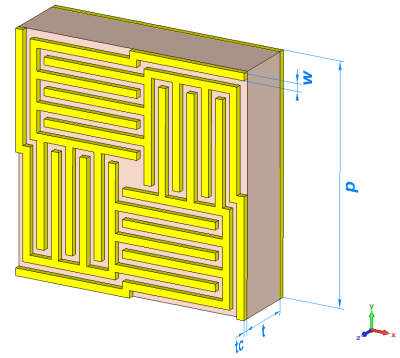 |
Improvement of the Transmit Efficiency Using a Miniaturized Artificial Magnetic Conductor Surface for RF shield at 9.4T
Haiwei Chen, Mingyan Li, Yang Gao, Chunyi Liu, Shanshan Shan, Aurelien Destruel, Ewald Weber, Feng Liu, Stuart Crozier
A novel structure for size-reduction of artificial magnetic conductor surface was designed for 9.4T MRI, aiming to improve the transmit efficiency of RF coils. This design achieved great miniaturization of the EBG unit cell size, which has been reduced to 4.48% of free-space wavelength. The reflection phase coefficient and the dispersion diagram are employed to characterize the EBG structure performance. Compared with a conventional metallic RF shielding plate, full-wave simulation results suggest that the proposed structure can achieve improved transmit efficiency.
|
09:51 |
1038. 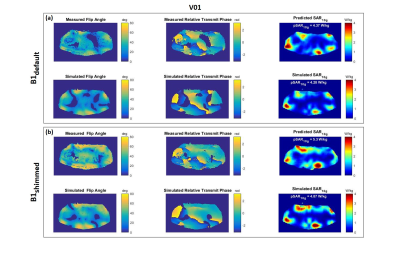 |
Experimental Validation of Subject-Specific Local SAR Assessment by Deep Learning
E.F. Meliadò, A.J.E Raaijmakers, B.R. Steensma, A. Sbrizzi, P.R. Luijten, C.A.T. van den Berg
Subject-specific local SAR assessment is one of the outstanding challenges of ultra-high field MRI. In this work, we present experimental, in-vivo results on four healthy subjects of a novel deep learning approach which provides online subject-specific local SAR distributions based on measured B1+ maps. Results are validated by creating a subject-specific model of each subject and calculate a reference local SAR distribution off-line by FDTD simulations. The results show that a Convolutional Neural Network (CNN) trained with synthetic MR data enables accurate subject-specific local SAR prediction during an MRI examination.
|
10:03 |
1039. 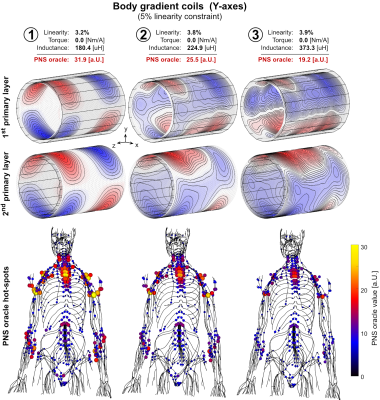 |
Peripheral Nerve Stimulation (PNS) constrained gradient coil design within a Boundary Element Method Stream Function (BEM-SF) optimization
Mathias Davids, Bastien Guérin, Lothar Schad, Lawrence Wald
Gradient system performance is increasingly constrained by Peripheral Nerve Stimulation (PNS). Nonetheless, gradient coil windings are optimized using the boundary element stream function method (BEM-SF) incorporating only non-biological metrics. We introduce direct incorporation of PNS constraints into a BEM-SF optimization in addition to the usual constraints. We pre-compute a novel PNS “oracle” matrix of each nerve segment’s likelihood to be excited by a given stream-function basis. The constraint is linear in current, so stimulation likelihood is a simple sum over all stream function bases. This allows convex optimization with a PNS constraint and examination of tradeoffs with linearity, inductance, torque and efficiency.
|
| 10:15 |
|
Adjournment |
 Back to Program-at-a-Glance |
Back to Program-at-a-Glance |  Back to Top
Back to Top